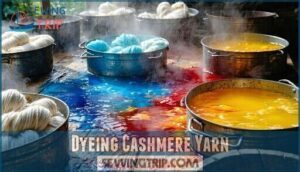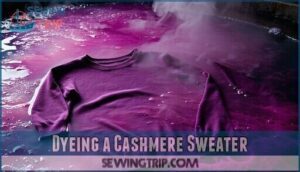This site is supported by our readers. We may earn a commission, at no cost to you, if you purchase through links.
 Yes, you can dye cashmere at home with proper care and technique.
Yes, you can dye cashmere at home with proper care and technique.
This delicate fiber responds well to acid-based dyes like Rit DyeMore or natural options like coffee, but requires low temperatures (under 140°F) and gentle handling to prevent felting or shrinkage.
Always pre-treat your cashmere piece, wet it thoroughly before dyeing, and maintain consistent water temperature throughout the process.
Hand-dyeing works best since machine agitation can damage the fibers.
The key is patience—rushing leads to uneven color or ruined garments.
Whether you’re revitalizing a faded sweater or completely transforming a scarf, cashmere’s natural protein structure actually holds dye quite well when you respect its temperamental nature.
With proper technique, you can achieve a beautiful, evenly dyed cashmere piece that looks like new, and the process can be very rewarding when done correctly, requiring gentle handling.
Table Of Contents
- Key Takeaways
- Can Cashmere Be Dyed?
- Tips for Hand Dyeing Cashmere
- Choosing The Right Dye for Cashmere
- Dyeing Cashmere With Dylon
- Dyeing Cashmere With Rit
- Using Coffee to Dye Cashmere
- Best Dye Options for Cashmere
- Dyeing Cashmere Yarn
- Dyeing a Cashmere Sweater
- Tie-Dyeing a Cashmere Sweater
- Dyeing a Cashmere Coat
- Dyeing a Cashmere Scarf
- Frequently Asked Questions (FAQs)
- Conclusion
Key Takeaways
- You can successfully dye cashmere at home – Use acid-based dyes like Rit DyeMore or natural options like coffee, keeping temperatures under 140°F to prevent felting and damage
- Temperature control is critical – Always use lukewarm water, avoid sudden temperature changes, and never expose cashmere to hot water, as this causes immediate shrinkage and felting
- Proper preparation ensures even results – Pre-wash your cashmere piece, keep it damp throughout the process, and test on a small hidden area first to preview the final color
- Gentle handling prevents damage – Hand-dyeing works best, since machine agitation ruins the fibers; stir slowly during the 30-minute process, and always lay flat to dry, rather than wringing or hanging
Can Cashmere Be Dyed?
Absolutely, you can dye cashmere! This luxurious fiber responds beautifully to dyeing when treated with respect.
The secret lies in understanding cashmere’s delicate nature and Fiber Types – it’s an animal protein that requires acid dyes and gentle handling.
Start with proper Cashmere Care: pre-wash your piece and keep it damp for ideal dye absorption. Choose wool-safe dyes and follow Dye Safety protocols.
Remember Color Theory – your original shade affects the final result. The cashmere dyeing process demands patience and low temperatures to prevent felting.
With proper cashmere dyeing techniques and careful Dye Fixation, you’ll achieve stunning results while preserving that coveted softness.
Tips for Hand Dyeing Cashmere
Hand dyeing cashmere transforms your wardrobe like an artist’s brush brings a canvas to life.
This delicate fiber demands respect, but with proper cashmere prep and fiber care techniques, you’ll achieve stunning results safely.
**Use lukewarm or cool water throughout the cashmere dyeing process.
Sudden temperature changes can shrink or felt your precious garment faster than you can say "expensive mistake."
**Mix dyes thoroughly before immersing the cashmere.
**Blend complementary colors like blue and yellow to create custom greens that store-bought options can’t match.
**Prioritize dye safety by protecting your skin and surfaces.
**Wear gloves, don old clothes, and spread towels in your workspace.
This prevents unwanted color fixing on everything except your cashmere.
Always test how to dye cashmere on a small swatch first.
Hand dye cashmere requires patience – dyeing cashmere wool successfully means gentle handling throughout.
For dye removal mistakes, act quickly with cool water rinses.
Let your newly dyed cashmere dry flat away from direct sunlight, then store in a dark, dry place to preserve your beautiful handiwork.
Choosing The Right Dye for Cashmere
Selecting the right dye for cashmere makes the difference between a stunning transformation and a costly mistake.
You’ll want acid dyes like Rit or Dylon for vibrant colors, or natural options like coffee and tea for subtle, eco-friendly results, using vibrant colors to achieve the desired effect.
Popular Fabric Dye Brands
Several commercial dyes work well for cashmere projects. Rit dye and Dylon dye offer accessible all-purpose options that handle protein fibers effectively with proper temperature control.
For superior results, acid dyes like Jacquard outperform fiber reactives substantially. Skip Procion MX dyes—they’re designed for cotton, not cashmere.
Natural dyes provide eco-friendly alternatives but require more patience and preparation time. When working with cashmere, consider using acid dye products for the best color results with proper temperature control.
Homemade Natural Dye Options
Creating homemade natural dyes opens up a world of eco-friendly possibilities for your cashmere projects.
Coffee grounds brew rich browns, while onion skins deliver golden yellows and warm oranges. Red cabbage creates stunning botanical hues from pink to deep purple, depending on your water’s pH.
Avocado pits and skins produce soft peach tones that complement cashmere beautifully. These plant dyes offer sustainable alternatives to commercial options.
By exploring natural dye sources, you can discover more unique and environmentally friendly ways to dye your cashmere, and this can lead to natural dyeing methods.
Tips for Successful Dyeing
Master these dye preparation and color theory fundamentals for professional results.
Pre-wet cashmere completely—dry spots create streaky disasters. Start with tepid water, then gradually increase temperature to prevent felting.
Add white vinegar for superior dye fixation and fiber care. Test small swatches first to preview outcomes.
Practice proper dye safety with gloves and ventilation. These cashmere dye tips guarantee even coverage when you dye cashmere safely.
Dyeing Cashmere With Dylon
Dylon offers wool-friendly formulations that work beautifully with cashmere when you follow proper cashmere dye methods. This brand’s cold-water dyes eliminate the temperature shock that can ruin delicate fibers.
Dylon Preparation starts with three key steps:
- Clean your cashmere thoroughly – Any residue blocks even color distribution
- Mix dye solution in room-temperature water – Hot water causes immediate felting
- Wear protective gear – Dylon stains everything it touches
Submerge your damp cashmere completely in the dye bath. Gentle stirring every ten minutes guarantees uniform coverage while protecting fiber structure. The standard thirty-minute soak delivers vibrant results, but you can extend this for deeper hues.
Color Enhancement happens gradually – rushing leads to blotchy results. When dyeing cashmere yarn or garments, Fiber Protection means avoiding aggressive agitation. Rinse in cool water until it runs clear, then add white vinegar for Dye Fixation.
Dylon’s Cashmere Safety profile makes it ideal for beginners tackling how to dye cashmere at home.
Dyeing Cashmere With Rit
Rit dye transforms your beloved cashmere pieces when you follow proper fiber safety protocols. Start with thorough cashmere preparation—pre-wash gently and keep damp for ideal dye uptake.
Mix Rit dye at 140°F maximum to prevent felting damage. Add vinegar for acid activation and stir constantly during Rit application.
| Step | Temperature & Time |
|---|---|
| Preparation | Cold water pre-wash |
| Dye Bath | 140°F for 30-60 minutes |
| Rinse | Gradual cooling to clear water |
Your dye color chart results depend on original fabric color—darker bases create muted tones. Test small swatches first to master cashmere dye methods before committing to full garments.
Using Coffee to Dye Cashmere
While commercial brands offer reliability, coffee presents an accessible natural dye cashmere option that’s surprisingly effective. This method transforms your kitchen into a dye studio without harsh chemicals.
Brew strong coffee using twice your normal grounds—the darker roast yields richer color depth. Let it cool completely before starting. You’ll need enough liquid to fully submerge your cashmere piece, so consider making a large batch.
Submerge your pre-dampened cashmere in the coffee bath, ensuring complete coverage. Soak for one to three hours depending on desired intensity. Coffee stains develop gradually, so patience rewards you with even coloration.
The natural acids in coffee help with dye fixation, though results won’t match commercial natural dyes. Expect warm browns ranging from light tan to deep chocolate. Different coffee varieties create unique shades—experiment with espresso versus regular grounds.
After achieving your target color, rinse thoroughly in cool water until it runs clear. Coffee dye offers excellent fiber safety since it’s naturally gentle. Lay flat to dry, and you’ll have successfully completed dyeing cashmere using pantry staples.
Best Dye Options for Cashmere
Cashmere’s delicate fibers deserve the right dye selection to maintain their luxurious feel. When you’re learning how to dye cashmere, choosing quality products makes all the difference between success and disaster.
The right dye transforms cashmere from tired to treasured – choose wisely for luxurious results.
Here’s your cashmere dyeing guide for selecting the best options:
- Acid Dyes – Professional-grade dyes like Jacquard create vibrant, lasting colors while ensuring fiber safety. They’re specifically formulated for protein fibers.
- Food Coloring – This gentle option offers natural hues without harsh chemicals. Perfect for beginners exploring natural dye cashmere techniques.
- Eco Dyes – Plant-based options provide sustainable color fixing while protecting delicate fibers. They require patience but reward you with beautiful results.
- Fabric Dyes – Commercial brands work well when you follow instructions carefully. Always test first on cashmere fiber dye samples.
Using the right cashmere dye kits is essential for achieving the desired color. Remember, successful dyeing cashmere yarn or garments starts with proper dye selection. Your cashmere will thank you with renewed vibrancy and maintained softness.
Dyeing Cashmere Yarn
Anyone can master the art of dyeing cashmere yarn with proper yarn preparation and technique. Start by winding your yarn into loose skeins and securing with figure-eight ties to prevent tangling. Presoak in lukewarm water with a splash of vinegar—this opens the fibers for better dye absorption and helps with dye fixation.
Understanding color theory is essential when dyeing cashmere yarn. Your base yarn color affects the final result, so light colors work best for vibrant shades. Create your dye bath using acid dyes specifically designed for protein fibers, ensuring fiber safety throughout the process.
Heat water gradually to avoid shocking the delicate cashmere fibers. Add yarn to the lukewarm dye bath and slowly increase temperature while stirring gently. The key to how to dye cashmere successfully is patience—rush the process and you’ll end up with felted yarn.
Natural dye cashmere options include coffee, tea, or plant-based dyes for eco-friendly results. After dyeing, proper yarn finishing involves cooling gradually and rinsing at matching temperatures. This cashmere fiber dye process lets you dye cashmere at home with professional-quality results.
Dyeing a Cashmere Sweater
Sweater makeovers reveal your creative potential when you follow proper cashmere dye instructions.
Start with thorough cashmere prep—hand wash your sweater in cool water with gentle detergent, then keep it damp for ideal dye absorption. Can you dye cashmere successfully? Absolutely, with careful temperature control and fiber safety measures.
Mix your chosen dye with warm (not hot) water, adding vinegar for better color fixing. Submerge the sweater completely, stirring gently for thirty minutes. This dyeing a cashmere sweater technique guarantees even coverage without damaging delicate fibers.
Rinse thoroughly at matching temperatures to prevent shock, then lay flat to dry for perfect results. Understanding the dye bath preparation is vital for achieving the desired color and maintaining the quality of the cashmere.
Tie-Dyeing a Cashmere Sweater
Transform your sweater into wearable art with tie-dye techniques that’ll make heads turn. This creative approach lets you break free from boring solid colors while maintaining cashmere’s luxurious feel.
Unleash your creativity and give tired cashmere a vibrant second life.
Start with these essential steps for cashmere dyeing success:
- Prep the fiber: Soak your clean cashmere sweater in warm water with a splash of white vinegar for 30 minutes to open the fibers
- Create color patterns: Use rubber bands to bind sections tightly – the tighter the band, the sharper your design lines will be
- Apply natural dyes: Coffee, tea, or diluted food coloring work great for subtle hues without harsh chemicals
Work in a handdye immersion bath at room temperature, gradually warming to prevent felting. After achieving your desired look, rinse gently until water runs clear. Proper dye fixation comes from that initial vinegar soak – it’s your secret weapon for lasting results.
Remember, sweater care doesn’t end with dyeing. Always lay flat to dry.
Dyeing a Cashmere Coat
Patience becomes your greatest ally when dyeing a cashmere coat. Success hinges on methodical coat preparation—clean your garment thoroughly with wool-safe detergent before starting.
Remove any stains or residue that could interfere with even color distribution. Your dye selection determines the final outcome.
Choose acid dyes like Rit or Dylon specifically formulated for animal fibers. Test a hidden seam first to preview results and confirm compatibility.
Fill a large basin with lukewarm water, following package directions precisely. Gradually lower your coat into the dye bath, avoiding temperature shock that causes felting.
Gentle stirring for 30 minutes ensures uniform saturation throughout the fabric. Color fixing requires adding white vinegar to set the dye permanently.
This vital step prevents future bleeding and maintains vibrancy. Post-dyeing fabric care involves thorough rinsing until water runs clear, then gentle squeezing—never wringing.
Reshape on a flat towel and air-dry completely. These dyeing techniques transform worn coats into stunning statement pieces while preserving cashmere’s luxurious texture.
Dyeing a Cashmere Scarf
Beyond the typical wash-and-wear routine, dyeing a cashmere scarf opens doors to endless style possibilities. Start by hand-washing your scarf with baby shampoo to guarantee maximum dye absorption.
Keep the fabric damp—this vital step enhances dye penetration throughout the delicate fibers. Create your dye bath using cold water and follow manufacturer ratios.
Gently submerge the damp scarf, stirring slowly for thirty minutes. This patience pays off with even color distribution. Check periodically—you’re the artist here, controlling the final shade.
For color fixing, rinse thoroughly in cool water until it runs clear. Never wring or twist; instead, gently squeeze out excess moisture. Lay flat on towels and reshape while damp to maintain the scarf’s original dimensions.
Proper scarves care during cashmere dyeing requires fiber safety awareness. When you dye cashmere fabric correctly, you’ll transform a tired accessory into your signature piece. The key to successful cashmere care dye projects? Gentle handling throughout every step.
Frequently Asked Questions (FAQs)
Can You dye Cashmere?
Like a chameleon changing its coat, you can absolutely dye cashmere with the right approach.
Use acid dyes like RIT or Dylon, pre-wash gently, maintain consistent cool temperatures, and handle delicately throughout the process to avoid felting or shrinkage.
Can You dye cashmere with RIT?
You can definitely dye cashmere with RIT dye, but you’ll need to be extra gentle.
Use RIT’s wool-safe formula, keep water temperature lukewarm, and avoid aggressive stirring to prevent felting or shrinkage.
How do you dye Cashmere yarn?
Cashmere yarn transforms like a chameleon when you wind it into skeins and secure loosely.
Use acid dyes in lukewarm water, adding vinegar for color-fastness.
Stir gently for thirty minutes, then rinse gradually at matching temperatures to prevent felting.
How do you remove dye from cashmere?
Use commercial color remover designed for delicate fabrics, following package instructions carefully.
Test on a hidden area first.
Work in cool water with gentle agitation, then rinse thoroughly and dry flat.
Can You dye a cashmere sweater?
Yes, you can successfully dye your cashmere sweater.
Hand-wash it first, then use wool-safe acid dyes like RIT or DYLON.
Keep temperatures consistent, stir gently, and avoid wringing to prevent felting.
Can you use color remover on Cashmere?
Color removal works on cashmere, but you’ll need a commercial color remover that’s compatible with wool fibers.
Test it first on a hidden area, use gentle handling, and maintain consistent cool temperatures to prevent felting or shrinkage damage, ensuring you follow proper care to avoid damage to the cashmere.
What kind of dye do you use on cashmere?
Absolutely game-changing for cashmere lovers!
You’ll want acid dyes like RIT, DYLON, or Procion MX for vibrant, long-lasting results.
Natural alternatives include coffee, tea, or plant-based dyes for eco-friendly coloring that won’t compromise your cashmere’s luxurious softness.
Can cashmere be dyed at home?
Home dyeing cashmere is totally doable, but it’s like handling a delicate butterfly—one wrong move and you’ll end up with felt instead of fabric.
Hand-dyeing with acid dyes works best.
Can I dye cashmere with Rit dye?
Worried Rit might damage your precious cashmere? Don’t be—it’s actually wool-safe! You’ll get beautiful results using Rit All-Purpose dye, just keep temperatures gentle and stir carefully to avoid felting.
What happens when you bleach cashmere?
Bleaching cashmere permanently damages the delicate fibers, causing them to weaken, break down, and lose their soft texture.
You’ll likely end up with a brittle, felted mess instead of luxurious cashmere.
Conclusion
Like Midas turning everything to gold, you now possess the knowledge to transform any cashmere piece with color.
Remember, success hinges on patience and proper technique—can you dye cashmere how to guides always emphasize gentle handling and temperature control.
Whether you’re using Rit DyeMore, natural coffee stains, or Dylon products, your cashmere will reward careful attention with beautiful, lasting results.
Take your time, follow the steps precisely, and you’ll achieve professional-quality dyeing from your own home.
- https://www.reddit.com/r/dyeing/comments/7ek2sv/definitive_advice_for_dyeing_cashmere/
- https://www.youtube.com/watch?v=qSMxbuJH0jo
- https://www.angelajey.com/blogs/cashmere/can-cashmere-be-washed-dye-and-ironed-at-home
- https://www.dharmatrading.com/dyes/dyes-for-dyeing-silk-wool-nylon.html
- https://botanicalcolors.com/mordant-monday-silk-cashmere-heat/















